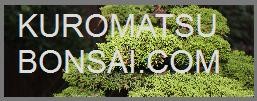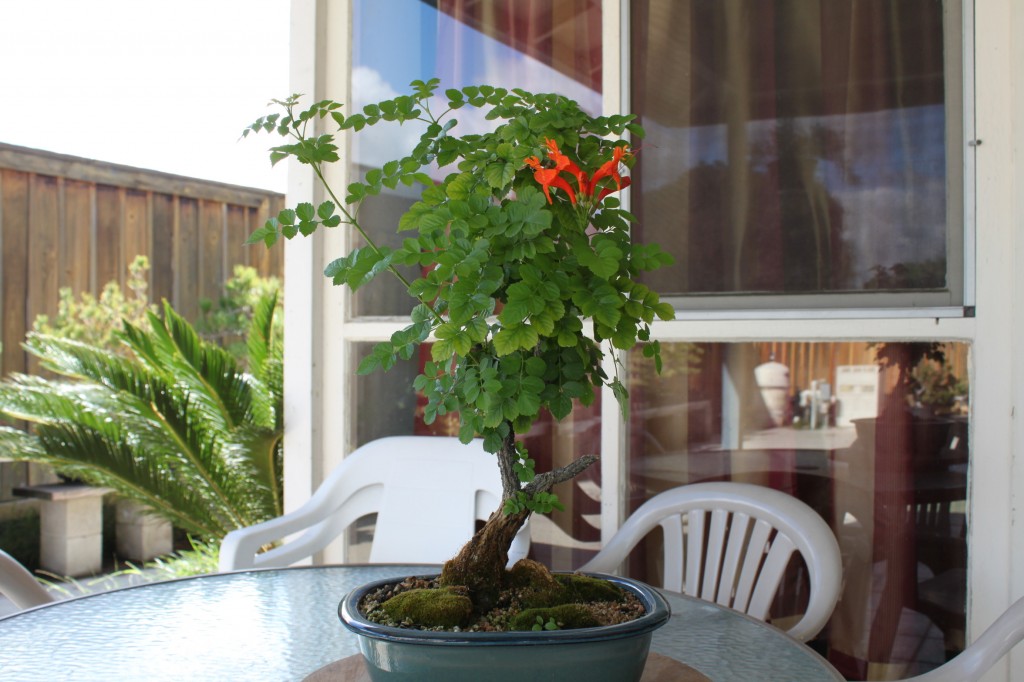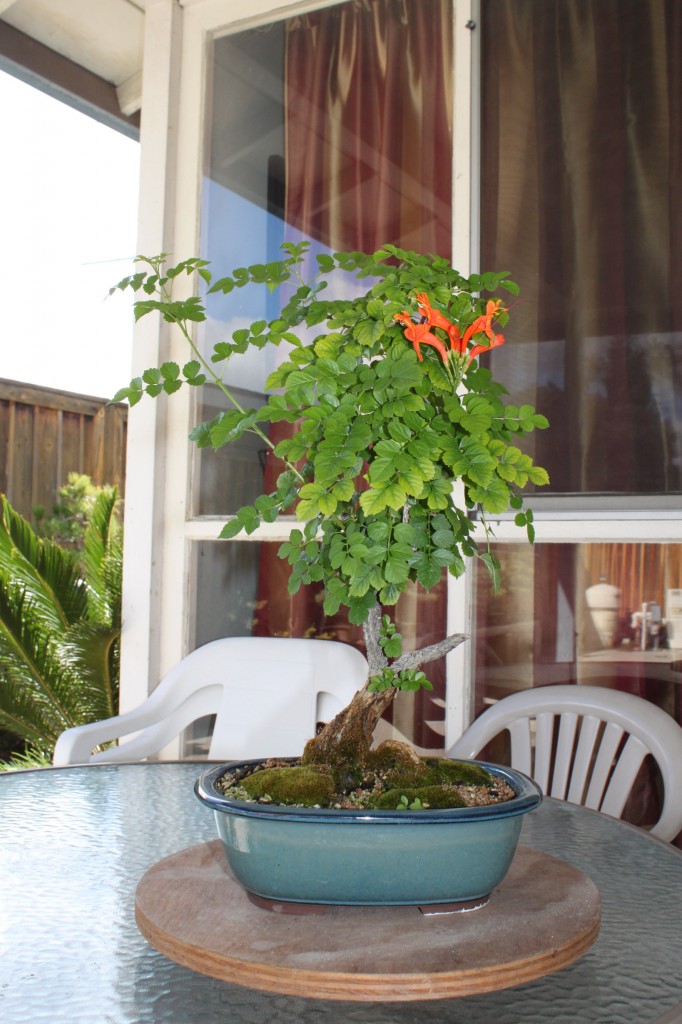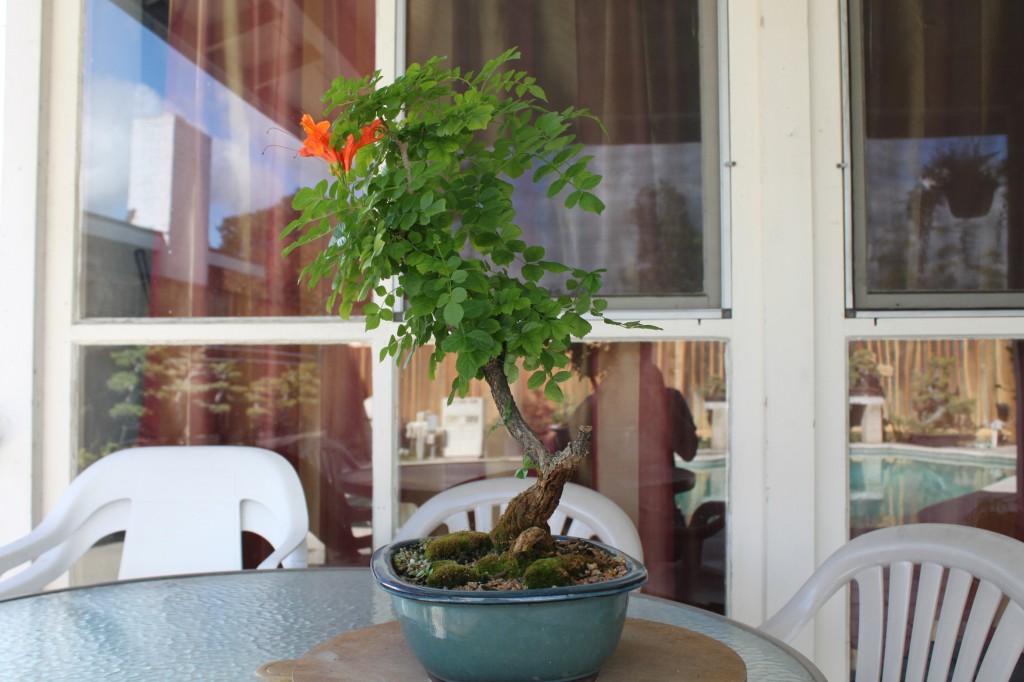Cape Honeysuckle Bonsai
Cape Honeysuckle Bonsai
Are you looking for an unusual bonsai? One that easily forms a heavy trunk with interesting bark, has bright green leaves and bright orange flowers? Try a Cape Honeysuckle.
Background:
Cape Honeysuckle, Tecoma Capensis, is a scrambling or vining shrub native to South Africa, Swaziland, and Mozambique. It is cultivated as an ornamental plant in the Southwestern United States, Hawaii, and in Southeast Asia. In some places, such as the Azores, it is considered an invasive pest.
Tecoma Capensis is nominally an evergreen, but it becomes semi-deciduous in colder climates, with the leaves turning pale yellow, dropping in winter, and re-growing the following spring. Flowers grow in clusters, and while they are usually orange, there are cultivars which produce flowers in yellow, salmon, or red. Fruit consists of a small legume style pod, and the seeds are borne inside the pod. Flowering will occur erratically throughout the growing season. The flowers tend to attract butterflies and hummingbirds.
Cape Honeysuckle’s primary (really only) use by man is as an ornamental plant, and as a hedging material. In places with warmer climates Cape Honeysuckle works very well for building hedges, as it responds well to pruning.
Where to Get One:
Digging one out of the ground is a possibility if you can find one with a small enough trunk. Cape Honeysuckle is very fast growing, and fitting a two foot diameter collected specimen into a bonsai pot is going to be a problem. The best strategy is to buy a five gallon specimen and fatten it up in the ground (you won’t have to wait long) or in a tub. Alternatively, if you find one in the ground that is too large, you can collect a sucker off of it or sever a runner. While the author has not tried it, it appears that Cape Honeysuckle would also propagate easily from thick cuttings.
Potting and Soil:
Cape Honeysuckle tends to be more temperate than tropical in its responses to bonsai culture. It prefers to be repotted in early spring, as it is emerging from dormancy, and repotting it later in warmer weather may cause growth to stall. Cape Honeysuckle responds readily to root pruning, but do not overdo it. Soil should be typical for tropical plants and broadleaf evergreens – 60% aggregate such as decomposed granite, agricultural pumice, turface or diatomite, and 40% organic matter. Since it is a flowering plant, it will need supplemental fertilizer, such as blood meal or bone meal.
With its bright orange flowers, Cape Honeysuckle tends to look better in a glazed bonsai pot. Color choices may be blue, green or cream.
Siting:
Cape Honeysuckle is a sun loving plant in nature, but as a bonsai, it needs some protection from the sun or it will dry out its soil very quickly. Giving it too much shade may slow down growth. Cape Honeysuckle does need frost protection in the winter.
Pruning and Shaping:
Cape Honeysuckle issues compound leaves off a central stem, and in order to build density you should prune back to one leaf or pair of leaves. Flowers issue on the ends of new growth, so if you want flowers, you are going to have to let your bonsai grow out until it issues flower buds. Cape Honeysuckle buds back with some reliability, so you can cut back to bare wood. Wire training works, but thick branches are difficult or impossible to bend, so wire when growth is still pliable.
Styling:
Formal upright is not going to work with this one. Informal styles are best, and group plantings are a possibility. Because of the flowers, and because flowering takes place on the end of new growth, larger sizes are best.
Closing Remarks:
If you are looking for a striking and unusual bonsai, Cape Honeysuckle will fill the bill.



